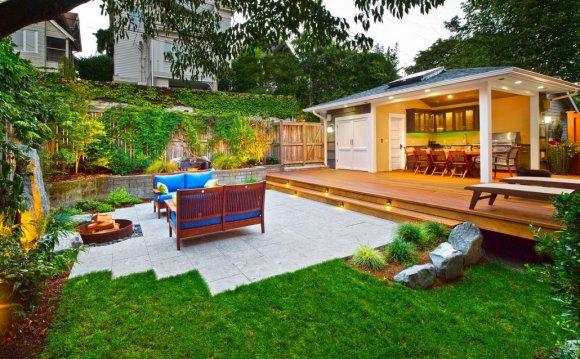
A well-designed landscape not only can add beauty to your home but also can reduce your heating and cooling costs. A well-placed tree, shrub, or vine can deliver effective shade, act as a windbreak, and reduce your energy bills. Carefully positioned trees can save up to 25% of the energy a typical household uses. Check out our Energy Saver 101 infographic for more ways your landscaping can help you save energy and water.
Climate
The energy-conserving landscape strategies you use depends on where you live. The United States can be divided roughly into four climate regions - temperate, hot-arid, hot-humid, and cool. See the map to find your climatic region. Below you'll find landscaping strategies listed by region and in order of importance.
Temperate Region
- Maximize warming effects of the sun in the winter.
- Tunnel summer breezes toward the home.
Hot-Arid Region
- Allow summer winds to access naturally cooled homes.
Hot-Humid Region
- Channel summer breezes toward the home.
Cool Region
- Allow the winter sun to reach south-facing windows.
Microclimate
The climate immediately surrounding your home is called its microclimate. When landscaping for energy efficiency, it's important to consider your microclimate as well as your regional climate.
Your home's microclimate may receive more sun, shade, wind, rain, snow, moisture, and/or dryness than average local conditions. If your home is located on a sunny southern slope, for example, it may have a warm microclimate, even if you live in a cool region. Or, even though you live in a hot-humid region, your home may be situated in a comfortable microclimate because of abundant shade and dry breezes. Nearby bodies of water may increase your site's humidity or decrease its air temperature. Microclimatic factors also help determine what plants may or may not grow in your landscape.
Source: energy.gov
Landscaping Tips
Though your home is your castle, there is no necessity to surround it with a moat. Here are 5 tips that will help you to make your landscaping feel more warm, welcoming and cozy.
1. Put some flowers nearby your entrance. Flowers make any area look more welcoming and attractive, so greeting your guests with Petunia, Snapdragon, Lily-of-the-Nile or some other garden flowers is always a great thing to do. What is more, to add some space between your house and the entrance, you can consider adding a little white fence. It will create an illusion that your front yard is bigger than it actually is. What is more, adding fence will create a great space for planting flowers to add some color and coziness.
2. Add rambling vines to make your yard look absolutely lovely. You can not deny that rambling vines always create romantic and even magical atmosphere. So why not to use this tip while decorating your yard?
3. To hide the unattractive driveway, consider adding some color, texture, and height. You can easily do it by adding various sorts of flowers. To start, create an island of green lawn right in the hub of a drive. Then add a couple of low boxwood hedges with flowers toward the back of your island.
4. If you want your yard to blossom and flourish bust still do not have enough time to maintain it, consider planting low-fuss lilies. Such flowers look absolutely gorgeous and come in the variety of rainbow hues, so you can pick the one you love most. What is more, low-fuss lilies do not care about the sort of soil, they love the sun and welcome hot, they do not afraid of drought. In other words, Crinums is an ideal flower for all those who are looking for low-maintenance solutions.
5. The last tip also touches the low-maintenance aspect. To make your life easier, group plantings into beds and islands. This will help you to avoid mowing and trimming around each individual plant, save a lot of time and even money.
















